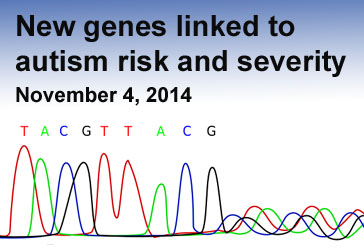Archives
November, 2014
Select a different month in the archive
Group Classes for Parents Yield Gains for Children
By Chelsea E. Toledo, M.A. on November 25, 2014

Background: Pivotal Response Treatment (PRT) is a child-led, play-based intervention intended to address target—or “pivotal”—areas of a child’s development, including motivation and initiation of social interactions. By focusing on these areas, PRT aims to induce broad social, behavioral, and communicative improvements in children with Autism Spectrum Disorder (ASD).
What’s new: On October 27, 2014, the Journal of Child Psychology and Psychiatry published the first-ever randomized controlled trial evaluating the effectiveness of PRT when administered by parents undergoing group training to deliver the intervention. A total of 53 children with ASD—aged two to six—participated in the study. Over the course of twelve weeks, parents of 27 children underwent group training to administer PRT in their homes, while the parents of the remaining 26 learned general information about ASD. Laboratory observations showed significant improvement in the number of utterances—such as saying “ball” to receive a ball—by children whose parents underwent PRT training.
Why it’s important: This study suggests that parents can become effective administrators of PRT after undergoing group classes—an efficient medium for disseminating information to a large number of affected families. Future studies could better examine PRT impact on social skills and determine the ideal balance of clinical interventions and at-home therapy.
Help me understand :
| Source(s) : |
| Tweet |
Researchers Search for Autism Blood Test
By Chelsea E. Toledo, M.A. on November 15, 2014

Background: Studies have shown that children with autism spectrum disorder (ASD) experience better outcomes the earlier they receive a diagnosis. Using currently available assessments—which include evaluations of language, behavior, and intellectual abilities—clinicians diagnose children with ASD at the average age of four.
What’s new: On November 7, 2014, the open-access journal PLoS One featured a study exploring techniques to find markers for ASD in the blood of affected individuals. The researchers compared the blood plasma of 39 children with ASD to that of 22 typically developing peers and found 179 features differentiating their blood. Using five different laboratory tests, the scientists tested for those same features in the blood of another set of children—13 with ASD and 8 with typical development—and were able to accurately classify them more than 80 percent of the time.
Why it’s important: This study moves the field closer to having a blood test for ASD, which would allow for earlier diagnosis and intervention. Future studies could refine which combination of biomarkers and which laboratory tests result in the most accurate diagnosis.
Help me understand :
| Source(s) : |
| Tweet |
Updated Catalog of Autism Genes Unveiled
By Sharmila Banerjee-Basu, PhD on November 4, 2014

Background: Autism Spectrum Disorder (ASD) is a genetically heterogeneous condition in which hundreds of genes have been associated with the disorder. Large consortiums of scientists are working together to better define the genetic underpinnings of autism. An unmet challenge in the field is how to connect the genetic profile to clinical features of ASD—a necessary first step for targeted treatment.
What’s new: Two research groups report an updated list of ASD risk genes based on statistical analysis that quantifies the genes’ role in the October 29, 2014, online issue of Nature. Both groups utilize exome sequencing—where scientists read only the protein coding part of the genome—to sequence the DNA of individuals with ASD and controls. The larger study, led by an International Consortium, sequenced 3,871 ASD cases and 9,937 controls. The other study analyzed more than 2,500 families with a single child affected by ASD from Simons Simplex Collection. Together, the studies reveal an updated list of ASD-associated genes, including several novel genes.
Why it’s important: The new studies have advanced our understanding of autism by replicating earlier findings of excess, spontaneously arising genetic glitches—known as de novo mutations—in ASD individuals. Another key finding addresses the gender bias in autism: ASD females and ASD males with low IQ have a different genetic risk architecture than ASD males with high IQ. Finally, the risk genes belonging to individuals with severe ASD significantly overlap with risk genes identified in Schizophrenia and Intellectual disability.
Help me understand :
| Source(s) : |
| Tweet |

